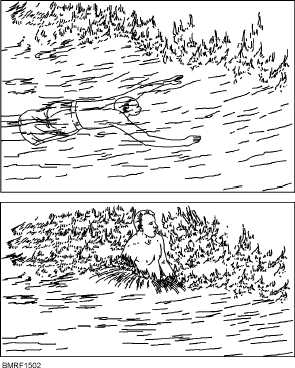After abandoning ship, you may have to swim fast,
slow, on the water, or under the water. You may have to
put on or take off clothes; carry or search for objects;
float for hours; or in shark-infested waters, lie still and
keep your arms and legs from dangling. There is a lot
you might have to do. You can get ready by practicing
all the strokes you know.
Almost all the Navy’s shore installations have
swimming facilities for your use. Here, you can practice
swimming. You should practice various strokes and
extend your swimming range. Then, you will feel more
confident that you can stay afloat and swim to a distant
lifeboat or floating object.
S W I M M I N G
T H RO U G H
F L A M E S . —
Flame-covered water is a terrifying sight. However, you
don’t need to be afraid of jumping into flames. If you
follow the procedures listed here, you will clear the
burning area safely (fig. 15-2).
1. Don’t wear an inherently buoyant life preserver
(if you have one on, get rid of it).
2. If you’re wearing a CO
2
preserver, keep it on but
don’t inflate it.
3. Discard your shoes because they will hinder
your underwater swimming.
4. Take a deep breath when you jump from the ship
and cover your nose and mouth with one hand
and your eyes with the other.
15-3
THIRD CLASS SWIMMER
1. Enter the water feet first from a height of 5 feet
2. Remain afloat for 5 minutes
3. Swim 50 yards
SECOND CLASS SWIMMER
1. Jump from a height of 10 feet
2. Remain afloat for 10 minutes
3. Swim 100 yards, using three survival strokes for
at least 25 yards each:
Breast stroke
Side stroke
Elementary back stroke
FIRST CLASS SWIMMER
1. Swim 220 yards
2. Enter the water feet first and immediately swim
25 yards underwater (you may surface for air
twice at 25-foot intervals)
3. Remove your trousers or slacks in the water and
inflate them
4. Tow another person 25 yards, using the
following methods:
Cross-chest carry
Extended reach (recommended for
struggling victims)
Grabbing the victims hair from behind and
use side stroke (recommended for towing
unconscious victims)
Figure 15-2.—Swimming through flames.
Student Notes:


